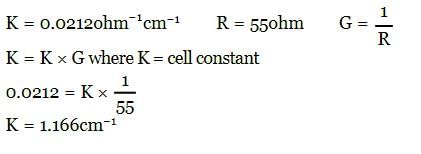Chemistry Exam > Chemistry Questions > The conductivity of N/10 KCl solution at 20&d...
Start Learning for Free
The conductivity of N/10 KCl solution at 20°C is 0.0212 S cm–1 and the resistance of cell containing this solution at 20°C is 55 ohm. The cell constant is:
- a)2.173 cm–1
- b)1.166 cm–1
- c)4.616 cm–1
- d)3.324 cm–1
Correct answer is option 'B'. Can you explain this answer?
Verified Answer
The conductivity of N/10 KCl solution at 20°C is 0.0212 S cm&ndash...

Most Upvoted Answer
The conductivity of N/10 KCl solution at 20°C is 0.0212 S cm&ndash...
Given information:
- Conductivity of N/10 KCl solution at 20°C = 0.0212 S cm^(-1)
- Resistance of cell containing the solution at 20°C = 55 ohm
To find:
Cell constant
Solution:
The conductivity of a solution is given by the equation:
Conductivity = (1 / Resistance) x Cell constant
We are given the conductivity and resistance, so we can rearrange the equation to solve for the cell constant:
Cell constant = Conductivity x Resistance
Substituting the given values into the equation, we get:
Cell constant = 0.0212 S cm^(-1) x 55 ohm
Calculating the product, we find:
Cell constant = 1.166 S cm^(-1)
Therefore, the correct answer is option 'B' (1.166 cm^(-1)).
Summary:
The cell constant is calculated using the equation Cell constant = Conductivity x Resistance. Substituting the given values, we find the cell constant to be 1.166 cm^(-1).
- Conductivity of N/10 KCl solution at 20°C = 0.0212 S cm^(-1)
- Resistance of cell containing the solution at 20°C = 55 ohm
To find:
Cell constant
Solution:
The conductivity of a solution is given by the equation:
Conductivity = (1 / Resistance) x Cell constant
We are given the conductivity and resistance, so we can rearrange the equation to solve for the cell constant:
Cell constant = Conductivity x Resistance
Substituting the given values into the equation, we get:
Cell constant = 0.0212 S cm^(-1) x 55 ohm
Calculating the product, we find:
Cell constant = 1.166 S cm^(-1)
Therefore, the correct answer is option 'B' (1.166 cm^(-1)).
Summary:
The cell constant is calculated using the equation Cell constant = Conductivity x Resistance. Substituting the given values, we find the cell constant to be 1.166 cm^(-1).
Free Test
FREE
| Start Free Test |
Community Answer
The conductivity of N/10 KCl solution at 20°C is 0.0212 S cm&ndash...
Given information:
- Conductivity of N/10 KCl solution at 20C is 0.0212 S cm-1
- Resistance of cell containing this solution at 20C is 55 ohm
Definition:
- Conductivity is the measure of a solution's ability to conduct electric current.
- Resistance is the measure of opposition to the flow of electric current.
- Cell constant is the ratio of the distance between the electrodes and the cross-sectional area of the electrodes.
Calculating the cell constant:
- The formula to calculate the cell constant is:
Cell constant (K) = Conductivity (κ) / Resistance (R)
- Substituting the given values:
K = 0.0212 S cm-1 / 55 ohm
K = 0.0212 / 55 cm-1
K = 0.000385 cm-1
- The cell constant is 0.000385 cm-1.
Checking the options:
a) 2.173 cm-1
b) 1.166 cm-1 (Correct Answer)
c) 4.616 cm-1
d) 3.324 cm-1
Explanation:
- The correct answer is option 'B' because it matches the calculated cell constant value of 0.000385 cm-1.
- The other options do not match the calculated value, so they are incorrect.
Conclusion:
- The cell constant of the N/10 KCl solution at 20C is 1.166 cm-1, which corresponds to option 'B'.
- Conductivity of N/10 KCl solution at 20C is 0.0212 S cm-1
- Resistance of cell containing this solution at 20C is 55 ohm
Definition:
- Conductivity is the measure of a solution's ability to conduct electric current.
- Resistance is the measure of opposition to the flow of electric current.
- Cell constant is the ratio of the distance between the electrodes and the cross-sectional area of the electrodes.
Calculating the cell constant:
- The formula to calculate the cell constant is:
Cell constant (K) = Conductivity (κ) / Resistance (R)
- Substituting the given values:
K = 0.0212 S cm-1 / 55 ohm
K = 0.0212 / 55 cm-1
K = 0.000385 cm-1
- The cell constant is 0.000385 cm-1.
Checking the options:
a) 2.173 cm-1
b) 1.166 cm-1 (Correct Answer)
c) 4.616 cm-1
d) 3.324 cm-1
Explanation:
- The correct answer is option 'B' because it matches the calculated cell constant value of 0.000385 cm-1.
- The other options do not match the calculated value, so they are incorrect.
Conclusion:
- The cell constant of the N/10 KCl solution at 20C is 1.166 cm-1, which corresponds to option 'B'.

|
Explore Courses for Chemistry exam
|

|
Question Description
The conductivity of N/10 KCl solution at 20°C is 0.0212 S cm–1 and the resistance of cell containing this solution at 20°C is 55 ohm. The cell constant is:a)2.173 cm–1b)1.166 cm–1c)4.616 cm–1d)3.324 cm–1Correct answer is option 'B'. Can you explain this answer? for Chemistry 2025 is part of Chemistry preparation. The Question and answers have been prepared according to the Chemistry exam syllabus. Information about The conductivity of N/10 KCl solution at 20°C is 0.0212 S cm–1 and the resistance of cell containing this solution at 20°C is 55 ohm. The cell constant is:a)2.173 cm–1b)1.166 cm–1c)4.616 cm–1d)3.324 cm–1Correct answer is option 'B'. Can you explain this answer? covers all topics & solutions for Chemistry 2025 Exam. Find important definitions, questions, meanings, examples, exercises and tests below for The conductivity of N/10 KCl solution at 20°C is 0.0212 S cm–1 and the resistance of cell containing this solution at 20°C is 55 ohm. The cell constant is:a)2.173 cm–1b)1.166 cm–1c)4.616 cm–1d)3.324 cm–1Correct answer is option 'B'. Can you explain this answer?.
The conductivity of N/10 KCl solution at 20°C is 0.0212 S cm–1 and the resistance of cell containing this solution at 20°C is 55 ohm. The cell constant is:a)2.173 cm–1b)1.166 cm–1c)4.616 cm–1d)3.324 cm–1Correct answer is option 'B'. Can you explain this answer? for Chemistry 2025 is part of Chemistry preparation. The Question and answers have been prepared according to the Chemistry exam syllabus. Information about The conductivity of N/10 KCl solution at 20°C is 0.0212 S cm–1 and the resistance of cell containing this solution at 20°C is 55 ohm. The cell constant is:a)2.173 cm–1b)1.166 cm–1c)4.616 cm–1d)3.324 cm–1Correct answer is option 'B'. Can you explain this answer? covers all topics & solutions for Chemistry 2025 Exam. Find important definitions, questions, meanings, examples, exercises and tests below for The conductivity of N/10 KCl solution at 20°C is 0.0212 S cm–1 and the resistance of cell containing this solution at 20°C is 55 ohm. The cell constant is:a)2.173 cm–1b)1.166 cm–1c)4.616 cm–1d)3.324 cm–1Correct answer is option 'B'. Can you explain this answer?.
Solutions for The conductivity of N/10 KCl solution at 20°C is 0.0212 S cm–1 and the resistance of cell containing this solution at 20°C is 55 ohm. The cell constant is:a)2.173 cm–1b)1.166 cm–1c)4.616 cm–1d)3.324 cm–1Correct answer is option 'B'. Can you explain this answer? in English & in Hindi are available as part of our courses for Chemistry.
Download more important topics, notes, lectures and mock test series for Chemistry Exam by signing up for free.
Here you can find the meaning of The conductivity of N/10 KCl solution at 20°C is 0.0212 S cm–1 and the resistance of cell containing this solution at 20°C is 55 ohm. The cell constant is:a)2.173 cm–1b)1.166 cm–1c)4.616 cm–1d)3.324 cm–1Correct answer is option 'B'. Can you explain this answer? defined & explained in the simplest way possible. Besides giving the explanation of
The conductivity of N/10 KCl solution at 20°C is 0.0212 S cm–1 and the resistance of cell containing this solution at 20°C is 55 ohm. The cell constant is:a)2.173 cm–1b)1.166 cm–1c)4.616 cm–1d)3.324 cm–1Correct answer is option 'B'. Can you explain this answer?, a detailed solution for The conductivity of N/10 KCl solution at 20°C is 0.0212 S cm–1 and the resistance of cell containing this solution at 20°C is 55 ohm. The cell constant is:a)2.173 cm–1b)1.166 cm–1c)4.616 cm–1d)3.324 cm–1Correct answer is option 'B'. Can you explain this answer? has been provided alongside types of The conductivity of N/10 KCl solution at 20°C is 0.0212 S cm–1 and the resistance of cell containing this solution at 20°C is 55 ohm. The cell constant is:a)2.173 cm–1b)1.166 cm–1c)4.616 cm–1d)3.324 cm–1Correct answer is option 'B'. Can you explain this answer? theory, EduRev gives you an
ample number of questions to practice The conductivity of N/10 KCl solution at 20°C is 0.0212 S cm–1 and the resistance of cell containing this solution at 20°C is 55 ohm. The cell constant is:a)2.173 cm–1b)1.166 cm–1c)4.616 cm–1d)3.324 cm–1Correct answer is option 'B'. Can you explain this answer? tests, examples and also practice Chemistry tests.

|
Explore Courses for Chemistry exam
|

|
Signup for Free!
Signup to see your scores go up within 7 days! Learn & Practice with 1000+ FREE Notes, Videos & Tests.


















